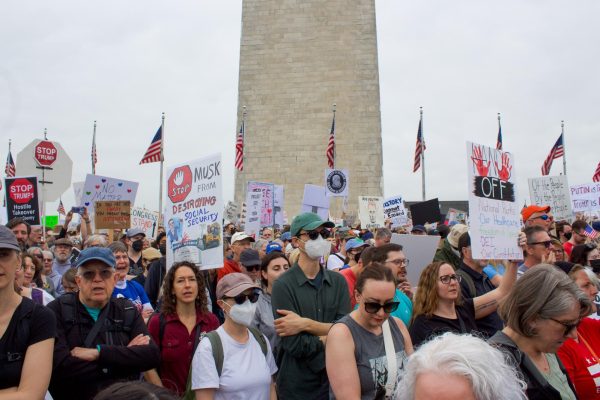Barry Farm: A Development Plan Shrouded In Uncertainty
FLY is the non-profit behind these meetings—a group promoting the educational and personal developments of low-income youth in Southeast D.C. This week’s topic: the city’s plan to demolish and redevelop 654 houses in the Barry Farm neighborhood.
In many ways, Barry Farm is a rough place to grow up. More than half of the heads of households are listed as unemployed, and the median income is $14,000. Jarima Richardson grew up in Barry Farm and went to Birney Elementary, the local public school. Recalling a conversation he had with an elementary school student, Richardson said one of the toughest parts of living in a neighborhood like Barry Farm is the psychological impact of pervasive violence on neighborhood youth.
“Students shouldn’t have to say, ‘oh no, I have to get in the house before dark because someone is going to shoot me.’”
Shanae Washington, who also attended the meeting, echoed Richardson.
“My mom grew up in Barry Farm and she said it’s not the same anymore. It used to be a family oriented community. Everybody took care of each other. But it’s not like that any more. It’s a terrible, terrible, terrible place.”
The conditions in Barry Farm are in need of change. In the capital of the world’s wealthiest nation, third world problems lie right across the Anacostia River. The question is not whether the District is aware of the poverty in Southeast, but how the city proposes to uplift its poorest neighborhoods, and what lies in store for residents.
The idea to renovate Barry Farm, along with neighboring housing projects Park Chester and Wade Road, was presented in 2005 by then-Mayor Anthony Williams. After a spike in violence and drug-related crimes culminated with the shooting of a 14-year-old girl in January 2004, the city government realized that something needed to change. Mayor Williams proposed the demolition of housing projects in poverty-ridden neighborhoods throughout D.C., replacing them with affordable housing for middle-income families to move into and poorer families to stay in. This would create a mixed-income community that lived in near identical housing units. The plan also sought to capitalize on 2005’s booming housing market by subsidizing certain units and maintaining others at market price; those who were able to afford the housing units could buy into the market, while lower-income families would be provided with affordable, subsidized homes.
Disregarding the concern over whether endemic violence can be quelled with bulldozers and incoming homeowners, the people who stand to see their homes demolished are worried. Making matters worse, the project appears to have no end in sight.
The largest concern among families has been the right to return to their redeveloped homes, which are being renovated under the Deputy Mayor for Planning and Economic Development’s “New Communities Initiative,” a city-wide revitalization project. They have released a 42-page document outlining the redevelopment, detailed mostly with idyllic sketches of life in the future Barry Farm. Only a single paragraph and vague bar graph, hidden away on page 39, explain how long residents will be displaced.
Candace Hetchler, the communities and evaluations coordinator at FLY, has been listening to the concerns of Barry Farm’s youth, and said that there is fear among residents whether “they will be able to find housing for their entire family, or if it’ll be the same price that they’re paying now when they return.”
“It makes me nervous, because whenever you see a project like this at a standstill there may be something else going on behind the scenes,” Hetchler said. “Then you never know, you could pull up to Barry Farm one day and find a bunch of bulldozers there.” She fears that developers are moving forward with the project, making decisions behind the backs of residents.
During the FLY meeting, the students complained about Mayor Adrian Fenty’s delivery of information about the halted redevelopment process. Richardson was particularly frustrated by the information he had received.
“Gradually over nine months, they’re like ‘Oh we’re just going to move some people,’” he said. “Then they’re like, ‘Oh a lot of you won’t be able to come back.’ That was a year and a half later. Then, ‘The majority of you all probably will have to go somewhere else; we’ll figure out where you can go.”
Fenty has deflected concerns about the opaqueness of the project. During a January 2008 press conference that announced another “New Communities” project in Columbia Heights, Fenty reiterated former Mayor Williams’s promise that “Every resident may come back.”
But can they really? Throughout the mid-1990s, with the help of Hope VI funds under the Clinton administration, urban housing projects have been demolished and redeveloped with surprising success; however, in many cases, only a third of the original residents end up coming back. Jonathan O’Connell of the Washington Business Journal wrote last year that after the redevelopment of many low-income housing projects across the US, including the notorious projects of Cabrini-Green in Chicago and East Lake in Atlanta, less than one third of the original residents returned.
Anthony Gualtieri who was directing the meeting with the FLY students, also cited concerns about Fenty’s promise.
“The right of return issue is a big sticking point.” He alluded to public housing regulations that often bar applicants with a troubled past. “Mayor Fenty said ‘yes, you can go back if you qualify. If you can test negative for drugs; if you don’t have a felony on your record; if you meet the requirements, whatever they may be.”
After four years of little to no headway in Barry Farm, the question stands: where is the project going from here? The answer: nowhere too soon.
It is no longer 2005, and the plan to redevelop has hit a stagnant housing market. According to O’Connell, the prospects for encouraging middle-income families to move into Barry Farm look grim; the amenities and other human services that attract middle-income families are nonexistent. The money needed to subsidize public housing isn’t there either.
Asked in an e-mail about how changing economic conditions will affect Barry Farm, O’Connell offered a pessimistic prognosis.
“The economy, and the housing market in particular, has worsened dramatically,” he said. “Prospects for a turnaround are still better here than for almost any part of the country, but it is still very difficult to finance construction of any kind. In addition, the city has less money to put into the initiative because of falling tax revenues.”
But in the meantime, residents will continue to wait with their fingers crossed, hoping they won’t be permanently displaced, and hoping the redevelopment will address their needs. A New Communities survey of Barry Farm youth found that employment and safety were the most pressing issues.
“You can fix it up, make it into condos, do whatever you want to do,” FLY’s Shanae Washington said. “But its not going to bring a big outcome until you figure out what the neighborhood actually wants; what the community actually wants.”






